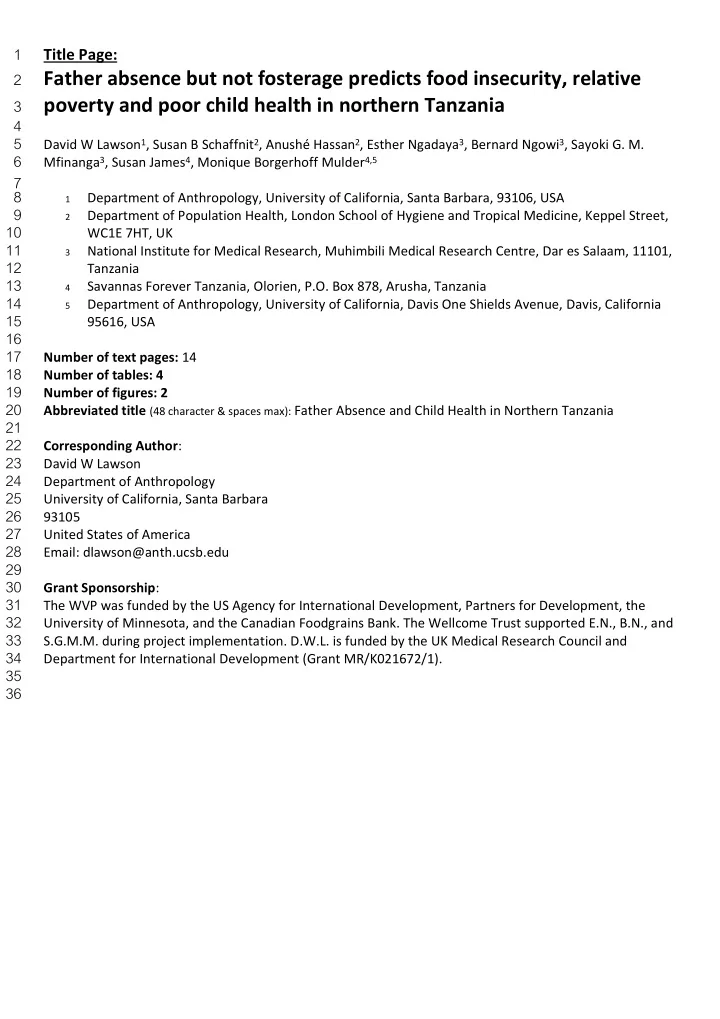

Title Page: 1 Father absence but not fosterage predicts food insecurity, relative 2 poverty and poor child health in northern Tanzania 3 4 5 David W Lawson 1 , Susan B Schaffnit 2 , Anushé Hassan 2 , Esther Ngadaya 3 , Bernard Ngowi 3 , Sayoki G. M. 6 Mfinanga 3 , Susan James 4 , Monique Borgerhoff Mulder 4,5 7 8 Department of Anthropology, University of California, Santa Barbara, 93106, USA 1 9 Department of Population Health, London School of Hygiene and Tropical Medicine, Keppel Street, 2 10 WC1E 7HT, UK 11 National Institute for Medical Research, Muhimbili Medical Research Centre, Dar es Salaam, 11101, 3 12 Tanzania 13 Savannas Forever Tanzania, Olorien, P.O. Box 878, Arusha, Tanzania 4 14 Department of Anthropology, University of California, Davis One Shields Avenue, Davis, California 5 15 95616, USA 16 17 Number of text pages: 14 18 Number of tables: 4 19 Number of figures: 2 20 Abbreviated title (48 character & spaces max): Father Absence and Child Health in Northern Tanzania 21 22 Corresponding Author : 23 David W Lawson 24 Department of Anthropology 25 University of California, Santa Barbara 26 93105 27 United States of America 28 Email: dlawson@anth.ucsb.edu 29 30 Grant Sponsorship : 31 The WVP was funded by the US Agency for International Development, Partners for Development, the 32 University of Minnesota, and the Canadian Foodgrains Bank. The Wellcome Trust supported E.N., B.N., and 33 S.G.M.M. during project implementation. D.W.L. is funded by the UK Medical Research Council and 34 Department for International Development (Grant MR/K021672/1). 35 36
37 ABSTRACT (250 words). 38 39 Objectives: The importance of fathers in ensuring child health in rural developing populations is 40 questioned by anthropologists and population health scientists. Existing literature focuses on paternal 41 death and child mortality. A relative lack of studies consider alternative forms of father absence and/or 42 more subtle health outcomes. Here we determine the frequency and form of father absence in northern 43 Tanzania, and its relationship to household food security, wealth and child anthropometric status. 44 Methods: We conducted a cross-sectional survey of 3136 children under five years from 56 villages. Using 45 multilevel regression we contrast children residing with both parents to those that (i) have experienced 46 paternal death, (ii) reside with their mother but not their living father and (iii) are fostered apart from both 47 living parents. 48 Results: 3.5% of children had experienced paternal death. 13% resided with their mother but away from 49 their living father. Supporting data indicate these cases primarily reflect parental divorce/separation, extra- 50 marital birth, or polygynous fathers residing with an alternative cowife. Paternal death and residing apart 51 from one’s living father was associated with lower food security and/or relative poverty and there is 52 suggestive evidence that children in such circumstances achieve lower height-for-age. 6% of children were 53 fostered, usually with grandparents, and were comparable to children residing with both parents in terms 54 of household food security, wealth and anthropometric status. 55 Conclusion: Our results highlight diversity in the form and consequences of father absence. We discuss 56 limitations of the current study and wider literature on fatherhood and make suggestions for future 57 research. 58 59 Key Words: Parental Investment, Fatherhood, Family Structure, Fostering, Child Health 60 61 1. INTRODUCTION 62 A large body of social science literature concerns the impact of father absence on child wellbeing in 63 ‘modern’ developed populations, particularly those in Europe and North America. This literature generally 64 demonstrates that father absence due to extra-marital birth, paternal death or divorce is predictive of poor 65 child wellbeing, although most research is limited to educational attainment and achievement, and to a 66 lesser extent mental wellbeing, rather than physical health outcomes (McLanahan et al. 2013). The role of 67 fathers in providing both direct child care and financial support, along with the socioeconomic 68 disadvantages of single-parent families are typically concluded as key mediators driving the negative 69 consequences of father absence. Related pathways such as the stress of parental relationship disruption 70 and impact of new unrelated father figures on the rearing environment of children may also be influential 71 (Daly & Wilson 1985; Lawson & Mace 2009). While debate remains regarding effect heterogeneity in 72 interaction with socioeconomic status and related environmental factors (e.g. Bernardi and Boertien 73 2016), negative relationships between father absence and indicators of child wellbeing are remarkably 74 consistent, including in studies utilising longitudinal analysis and related methods capable of isolating 75 causality (McLanahan et al. 2013). The impact of father absence in rural developing populations is a much 76 more contested issue, with recent scholarship challenging the traditionally held belief that father absence 77 is necessarily detrimental to children. This shift is recognizable within both anthropology and the wider 78 population health science and policy literature. 79 80 Historically, evolutionary anthropology painted a picture of the nuclear family, with paternal investment 81 critical to offspring provisioning – an observation thought to account for the emergence of biparental care 82 in humans compared to our primate relatives (Lovejoy, 1981). This model has gradually given way to an 83 understanding that humans typically rely on larger cooperative networks of extended kin to raise children, 84 and that the importance of fathers and other kin varies both across and within populations. For example, 85 Sear and Mace (2008) conducted an influential review of large number (n=45) of anthropological and 86 demographic studies considering whether or not the presence/absence of alternative categories of kin 87 (usually measured as currently alive or dead) predicts child survival in contexts of high child mortality and 88 high fertility (primarily farming and patrilocal populations). In only one out of three studies providing
Recommend
More recommend